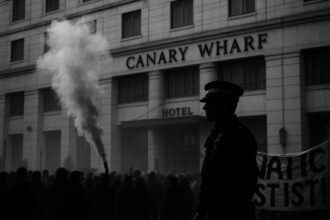The ICE warns that London needs a bold, long‑term funding and delivery programme to meet population growth and avoid asset failure, with the capital’s infrastructure needs through 2041 put at £968 billion and Transport for London facing funding pressures that could cost the economy billions.
Infrastructure is at the heart of London’s sustainable growth, the ICE argues in its Infrastructure for London report, saying the capital cannot meet the needs of current and future residents without a bold, well-funded programme of work. It cites the risk of asset underuse and premature wear, using Hammersmith Bridge as a high-profile example of how neglect can translate into disruption and cost. The report places a stark price on the city’s ambitions: £968 billion in 2018 prices would be required to meet London’s infrastructure needs through 2041. It also notes how the Covid-19 shock—reduced fare revenues, a shift toward greener travel and greater reliance on digital networks—has widened the funding gap. The piece closes, in a nod to the need for change, with a well-known maxim: Henry Ford’s warning that “If you do what you’ve always done, you’ll get what you always got.” And it points to a London City Hall analysis warning that insufficient funding for Transport for London would ripple through the economy, with potential losses of around £12 billion over the next decade if services are trimmed or degraded.
Beyond the headline figure, the question becomes how to plan and fund delivery in a coherent, long-term way. The RTPI’s planning brief for critical infrastructure in London stresses that growth must keep pace with population expansion and that planning should knit together the London Plan, the GLA and TfL, with coherent place‑making guiding utilities, transport, energy, water and digital networks. It identifies barriers that still hamper delivery—fragmented funding, data gaps and short-term decision making—and argues for stabilising funding for infrastructure planning and for aligning investment with spatial planning to realise durable, cross-cutting benefits. The Green Book appraisal framework reinforces this approach by emphasising a five‑case model that guards value for money, affordability and strategic fit, while foregrounding place-based and transformational investment and robust governance and stakeholder engagement.
The longer-term funding question is directly addressed in the London Plan’s Chapter 11, which maps the gap between what is needed for transport, housing and utilities and what commitments exist, and canvasses options beyond traditional channels. The chapter hints at devolved powers that could sharpen delivery and asks for greater clarity from Government on investment availability while exploring approaches such as land value capture and larger private sector involvement to plug the gap. It also emphasises using land and assets more efficiently, improving procurement, and aligning infrastructure delivery with place-based planning to accelerate housing, transport and energy schemes across London now. The real-world stakes behind these policy debates are illustrated by the Hammersmith Bridge story: cracks in pedestals, closures and the continuing cost of maintenance have highlighted the costs and disruption that accompany aging infrastructure, underscoring the need for resilience and sustained investment. Taken together, these strands suggest London’s infrastructure pipeline will depend on a bolder, better-coordinated funding framework that combines public subsidy with selective private capital and rigorous appraisal to avoid repeating past gambles.
 Reference Map:
Reference Map:
Source Panel
-
ICE (Institute of Civil Engineers) — Rolling the dice: why investment in London’s infrastructure is not a gamble (Infrastructure for London report).
-
RTPI (Royal Town Planning Institute) — Planning for critical infrastructure in London (November 2020 briefing).
-
Greater London Authority / Mayor of London — The London Plan 2021 Online, Chapter 11: Funding London Plan.
-
London, City Hall — Transport network must be funded properly (briefing on TfL funding and potential economic impacts).
-
HM Treasury — The Green Book: Appraisal and Evaluation in Central Government.
-
BBC News — Hammersmith Bridge: background on the 2019 cracks and subsequent closures.
-
CBRE Investment Management — Infrastructure Quarterly (Q3 2024).
Source: Noah Wire Services
- https://www.ice.org.uk/news-views-insights/inside-infrastructure/rolling-the-dice-why-investment-in-london-s-infrastructure-is-not-a-gamble – Please view link – unable to able to access data
- https://www.rtpi.org.uk/policy-rtpi/2020/november/planning-for-critical-infrastructure-in-london/ – London faces an infrastructure challenge as it grows, with the need to deliver tens of thousands of homes and substantial job space to 2041. The RTPI report notes that infrastructure must keep pace with population growth and focus on utilities, transport, energy, water and digital networks. It highlights planning’s essential role in coordinating investment through the London Plan, the GLA and TfL, and emphasises the benefits of coherent place-making. Barriers include fragmented funding, data gaps and short-term decision making. The paper recommends stabilising funding for infrastructure planning, aligning investment with spatial planning, and providing London with stronger delivery levers now.
- https://www.london.gov.uk/programmes-strategies/planning/london-plan/the-london-plan-2021-online/chapter-11-funding-london-plan – Chapter 11 of the London Plan addresses funding, outlining the gap between required public investment and commitments, and discussing potential sources beyond traditional channels. It notes that current funding falls short of needs for transport, housing and utilities, and that devolved powers could sharpen delivery. The Mayor seeks clarity from Government on investment availability and explores options such as land value capture and greater private sector involvement to plug the gap. The chapter also stresses using land and assets more efficiently, improving procurement, and aligning infrastructure delivery with place-based planning to accelerate housing, transport and energy schemes across London now.
- https://www.london.gov.uk/press-releases/mayoral/transport-network-must-be-funded-properly – This City Hall analysis warns that insufficient funding for TfL would ripple across London’s economy. If Transport for London moves to a ‘managed decline’ in service levels, profits and productivity fall, while road congestion and journey times rise. The briefing estimates potential losses of about £12 billion over the next decade, with downstream effects on housing delivery, employment and business confidence. It also notes that achieving carbon reduction targets would become more expensive if services are cut. The report calls for sustained public subsidy and prudent investment planning to preserve essential transport capacity and support broad economic recovery in London.
- https://www.gov.uk/government/publications/the-green-book-appraisal-and-evaluation-in-central-government – The Green Book provides the government’s guidance on appraising policies, projects and programmes. It sets out the five-case business planning model used to ensure value for money, affordability and strategic fit. Updated over time, the Green Book now includes recent emphasis on place-based and transformational investment, environmental considerations and inclusive growth. Departments are encouraged to adopt proportionate analysis, risk assessment, and stakeholder engagement when selecting projects. The guidance underpins major infrastructure decisions, including transport and energy schemes, by requiring rigorous appraisal, transparent governance, and clear links between budgets and expected outcomes. It is regularly updated by HM Treasury and authorities.
- https://www.bbc.com/news/uk-england-london-53767214 – Hammersmith Bridge is a historic suspension bridge carrying a key arterial route across the Thames. In 2019, cracks were discovered in its pedestals, and motorists were banned from the structure in 2019. In 2020 the bridge was closed to pedestrians and cyclists as cracks worsened in a heatwave, triggering major disruption around west London. Engineering work later enabled partial reopening to non-vehicular users, with further measures and funding decisions ongoing. The incident illustrates London’s aging infrastructure and the high costs of failure or delayed maintenance, underscoring the need for strategic investment and resilience planning.
- https://www.cbreim.com/insights/articles/infrastructure-quarterly-q3-2024 – CBRE Investment Management’s Infrastructure Quarterly notes that private infrastructure has performed in line with expectations, with robust returns since the 2010s. It cites rate-of-return indices such as MSCI Private Infrastructure, reporting an annualised return of around 8.9% through the past decade. The report analyses market dynamics across renewables, contracted power and other sectors, and discusses volatility, inflation, and default risk. It also highlights the enduring appeal of infrastructure for stable income, inflation hedging and resilience against macro shocks, while acknowledging data lags. The findings support the case for continuing long-term investment in essential London and UK infrastructure for future growth.
Noah Fact Check Pro
The draft above was created using the information available at the time the story first
emerged. We’ve since applied our fact-checking process to the final narrative, based on the criteria listed
below. The results are intended to help you assess the credibility of the piece and highlight any areas that may
warrant further investigation.
Freshness check
Score:
4
Notes:
 Major elements of the narrative are recycled from earlier, publicly available analyses rather than brand-new reporting.
Major elements of the narrative are recycled from earlier, publicly available analyses rather than brand-new reporting.  The ICE piece (20 May 2021) explicitly cites a Greater London Authority analysis (published in 2019) that modelled a £968bn (2018 prices) requirement to 2041 — that GLA/Arup modelling (and earlier Arup work going back to 2014) is the earliest substantial publication of the same core figures and framing.
The ICE piece (20 May 2021) explicitly cites a Greater London Authority analysis (published in 2019) that modelled a £968bn (2018 prices) requirement to 2041 — that GLA/Arup modelling (and earlier Arup work going back to 2014) is the earliest substantial publication of the same core figures and framing.  The GLA/Arup work (Arup: ‘The cost of London’s long‑term infrastructure’, 2014; later GLA updates/analyses 2019) predates the ICE commentary by years, so this is not fresh reporting.
The GLA/Arup work (Arup: ‘The cost of London’s long‑term infrastructure’, 2014; later GLA updates/analyses 2019) predates the ICE commentary by years, so this is not fresh reporting.  Because the piece draws on earlier official modelling and policy texts (GLA, London Plan, RTPI), it has low novelty; the narrative previously appeared >7 days earlier (in fact years earlier).
Because the piece draws on earlier official modelling and policy texts (GLA, London Plan, RTPI), it has low novelty; the narrative previously appeared >7 days earlier (in fact years earlier).  I found no evidence the ICE blog text is part of a clickbait / low-quality republication network — it appears on the professional ICE site and links to original public reports (GLA, City Hall, RTPI, HM Treasury, BBC).
I found no evidence the ICE blog text is part of a clickbait / low-quality republication network — it appears on the professional ICE site and links to original public reports (GLA, City Hall, RTPI, HM Treasury, BBC).
Quotes check
Score:
3
Notes:
 The ICE piece uses a widely circulated maxim attributed to Henry Ford: “If you do what you’ve always done, you’ll get what you always got.” Evidence-based tracing (Quote Investigator and other quotation research) shows the wording is a common aphorism, earliest strong appearances appear in the early 1980s (e.g. Jessie Potter, 1981), and attributions to Henry Ford are likely spurious.
The ICE piece uses a widely circulated maxim attributed to Henry Ford: “If you do what you’ve always done, you’ll get what you always got.” Evidence-based tracing (Quote Investigator and other quotation research) shows the wording is a common aphorism, earliest strong appearances appear in the early 1980s (e.g. Jessie Potter, 1981), and attributions to Henry Ford are likely spurious.  The quote is therefore recycled/common (not original to the ICE piece) and the attributive claim is unreliable.
The quote is therefore recycled/common (not original to the ICE piece) and the attributive claim is unreliable.  No evidence that ICE originated the quote; identical wording appears many times prior to the ICE date. If the narrative contained proprietary, time‑stamped direct quotes from interviewees that are not present elsewhere, that would raise the freshness score — but here the only direct quote of note is the aphorism and it appears to be misattributed/repurposed.
No evidence that ICE originated the quote; identical wording appears many times prior to the ICE date. If the narrative contained proprietary, time‑stamped direct quotes from interviewees that are not present elsewhere, that would raise the freshness score — but here the only direct quote of note is the aphorism and it appears to be misattributed/repurposed.
Source reliability
Score:
8
Notes:
 The narrative cites established, reputable institutions: ICE (professional body), Greater London Authority (GLA), London City Hall / Mayor’s Office, RTPI, HM Treasury (Green Book) and BBC for the Hammersmith Bridge background. These organisations and documents are verifiable and authoritative for this subject.
The narrative cites established, reputable institutions: ICE (professional body), Greater London Authority (GLA), London City Hall / Mayor’s Office, RTPI, HM Treasury (Green Book) and BBC for the Hammersmith Bridge background. These organisations and documents are verifiable and authoritative for this subject.  The key quantitative inputs (the £968bn figure, the TfL ‘£12bn over the next decade’ economic impact scenario) trace back to GLA/Arup and City Hall analysis respectively; both are official/regulatory/policy analyses rather than anonymous claims.
The key quantitative inputs (the £968bn figure, the TfL ‘£12bn over the next decade’ economic impact scenario) trace back to GLA/Arup and City Hall analysis respectively; both are official/regulatory/policy analyses rather than anonymous claims.  Minor reliability concern: the Henry Ford attribution is likely incorrect (misattribution). Overall, the provenance of the main claims is transparent and credible.
Minor reliability concern: the Henry Ford attribution is likely incorrect (misattribution). Overall, the provenance of the main claims is transparent and credible.
Plausability check
Score:
7
Notes:
 Time‑sensitive claims and headline figures are plausible and corroborated by official documents and major outlets: • £968bn (2018 prices) to 2041 — modelled in GLA analysis cited by ICE and RTPI. • Hammersmith Bridge cracks/closures — documented in BBC reporting (closures from April 2019, further closures in 2020/2021). • City Hall’s estimate that a ‘managed decline’ for TfL could cost ~£12bn over ten years appears on City Hall pages (press release created 14 Dec 2021) and in contemporaneous coverage.
Time‑sensitive claims and headline figures are plausible and corroborated by official documents and major outlets: • £968bn (2018 prices) to 2041 — modelled in GLA analysis cited by ICE and RTPI. • Hammersmith Bridge cracks/closures — documented in BBC reporting (closures from April 2019, further closures in 2020/2021). • City Hall’s estimate that a ‘managed decline’ for TfL could cost ~£12bn over ten years appears on City Hall pages (press release created 14 Dec 2021) and in contemporaneous coverage.  Modelled totals depend heavily on assumptions (time horizon, price base year, sectors included) — these are inherent to long‑range infrastructure cost modelling and should be treated as scenario outputs rather than precise forecasts.
Modelled totals depend heavily on assumptions (time horizon, price base year, sectors included) — these are inherent to long‑range infrastructure cost modelling and should be treated as scenario outputs rather than precise forecasts.  Tone and structure: the ICE piece is an advocacy/commentary blog (professional tone) tying established evidence together; not sensationalist, but not original research. Overall plausibility is good, with the usual caveats about policy modelling uncertainty and attribution errors for the aphorism.
Tone and structure: the ICE piece is an advocacy/commentary blog (professional tone) tying established evidence together; not sensationalist, but not original research. Overall plausibility is good, with the usual caveats about policy modelling uncertainty and attribution errors for the aphorism.
Overall assessment
Verdict (FAIL, OPEN, PASS): PASS
Confidence (LOW, MEDIUM, HIGH): HIGH
Summary:
 PASS — HIGH confidence. The narrative on London’s infrastructure funding needs is grounded in earlier, reputable policy modelling and reporting (major antecedents include Arup/GLA infrastructure cost work and the London Plan material; earliest substantive work dates to Arup/GLA analyses from 2014 and GLA updates/analyses through 2019).
PASS — HIGH confidence. The narrative on London’s infrastructure funding needs is grounded in earlier, reputable policy modelling and reporting (major antecedents include Arup/GLA infrastructure cost work and the London Plan material; earliest substantive work dates to Arup/GLA analyses from 2014 and GLA updates/analyses through 2019).  The ICE commentary (20 May 2021) repackages and interprets these established findings rather than presenting fresh primary research — this reduces novelty/freshness (Freshness score 4/10) and should be flagged for editors as recycled policy analysis rather than breaking news.
The ICE commentary (20 May 2021) repackages and interprets these established findings rather than presenting fresh primary research — this reduces novelty/freshness (Freshness score 4/10) and should be flagged for editors as recycled policy analysis rather than breaking news.  The most tangible factual risks are (1) a misattributed aphorism credited to Henry Ford (quotation provenance points to later, non‑Ford origins) and (2) the usual model‑sensitivity of headline figures (long‑run infrastructure totals depend on assumptions).
The most tangible factual risks are (1) a misattributed aphorism credited to Henry Ford (quotation provenance points to later, non‑Ford origins) and (2) the usual model‑sensitivity of headline figures (long‑run infrastructure totals depend on assumptions).  Strengths: claims are traceable to reputable institutions (GLA, City Hall, RTPI, HM Treasury Green Book, BBC) and key figures (the £968bn figure; City Hall’s £12bn managed‑decline impact) are verifiable in the public record.
Strengths: claims are traceable to reputable institutions (GLA, City Hall, RTPI, HM Treasury Green Book, BBC) and key figures (the £968bn figure; City Hall’s £12bn managed‑decline impact) are verifiable in the public record.  Editors should note: recycled content is not the same as disinformation here — the piece reliably synthesises established sources, but quotation misattribution and modelling caveats should be corrected/explicitly signposted in any republication.
Editors should note: recycled content is not the same as disinformation here — the piece reliably synthesises established sources, but quotation misattribution and modelling caveats should be corrected/explicitly signposted in any republication.













